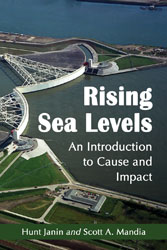My Three Presentations for AGU 2012 Fall Meeting
I travel once again to one of my favorite cities in the world, San Francisco, California to take part in the American Geophysical Union’s 2012 Fall Meeting. This year I will be presenting two oral talks and one poster. Please consider stopping by if you are attending AGU.
MONDAY December 3:
Session: PA14A. New Ideas in Geoscience and Environmental Communication I Convener(s): Yekaterina Kontar (University of Nebraska-Lincoln) and Jeanette Drake (The University of Findlay) 4:00 PM – 6:00 PM; 302 (Moscone South)
My oral presentation:
4:30 PM – 4:45 PM, PA14A-03. Filling the Knowledge Gap that Exists Between the Public and Its Leaders and Climate Science Experts (Invited)
Scott A. Mandia; John P. Abraham; Jan W. Dash; Michael C. Ashley
Abstract:
There is a gap between what the general public and its elected leaders know about climate change and what climate scientists understand about this critical issue. One such effort by the authors to fill this gap is the Climate Science Rapid Response Team (CSRRT), formed in November 2010 to provide rapid, high-quality climate science information to international news media and lawmakers. Currently, CSRRT has enlisted 250 top climate scientists, including those with expertise on the economics and policy matters, whom are committed to be on call for climate-related inquiries. CSRRT has responded to more than 300 inquiries including, from among many others, The White House, Congress, and local governmental officials, major television and cable news networks, radio programs, mainstream international newspaper outlets, and a broad range of online news providers. CSRRT scientists have also been provided extensive communication training to help encourage the use of jargon-free language so that clear communication with the broader public can be more successful.
In addition to the CSRRT, the authors have undertaken several behind the scenes initiatives to increase public awareness about climate change. This presentation will describe the operation of CSRRT along with some of its highlights, as well as offer a peek into the authors’ less public efforts that have had a major impact on various climate-related news stories and policy.
MONDAY December 3:
Session PA13A. Strategies for Neutralizing the Negative Commercial Influence on the Discussion Around Climate Science Posters
Convener(s): Gretchen Goldman (Union of Concerned Scientists) and Francesca Grifo (Union of Concerned Scientists)
1:40 PM – 6:00 PM; Hall A-C (Moscone South)
My poster:
PA13A-1987. Navigating Negative Conversations in Climate Change (Invited)
Scott A. Mandia; John P. Abraham; Jan W. Dash; Michael C. Ashley
Abstract:
Politically charged public discussions of climate change often lead to polarization as a direct result of many societal, economic, religious and other factors which form opinions. For instance, the general public views climate change as a political discussion rather than a scientific matter. Additionally, many media sources such as websites and mainstream venues and persons have served to promote the “controversy”.
Scientists who engage in a public discourse of climate change often encounter politically charged environments and audiences. Traditional presentations of the science without attention paid to political, social, or economic matters are likely to worsen the existing divide.
An international organization, the Climate Science Rapid Response Team (CSRRT) suggests a strategy that can be used to navigate potentially troublesome situations with divided audiences. This approach can be used during live lecture presentations, and radio, print, or television interviews.
The strategy involves identifying alternative motivations for taking action on climate change. The alternative motivations are tailored to the audience and can range from national defense, economic prosperity, religious motivation, patriotism, energy independence, or hunting/fishing reasons.
Similar messaging modification can be used to faithfully and accurately convey the importance of taking action on climate change but present the motivations in a way that will be received by the audience.
THURSDAY December 6:
Session ED42A. Climate Literacy: Higher Education Efforts in Climate Change Education II
Convener(s): Anne Gold (CIRES/CU Boulder-Rsrch Lab 2) and Miriam Bertram (University of Washington)
10:20 AM – 12:20 PM; 302 (Moscone South)
My oral presentation:
11:35 AM – 11:50 AM, ED42A-06. A Model for Teaching a Climate Change Elective Science Course at the Community College Level
Scott A. Mandia
The impact of global climate change is far-reaching, both for humanity and for the environment. It is essential that our students be provided a strong scientific background for the role of natural and human caused climate change so that they are better prepared to become involved in the discussion.
Here the author reveals a successful model designed for use with a diverse student body at the community college level. Teaching strategies beyond the traditional lecture and exam style include: web-based resources such as static websites along with dynamic blogging tools, post-lecture cooperative learning review sessions, weekly current event research projects, use of rubrics to assist students in their own project evaluation before submission, and a research paper utilizing the Skeptical Science website to examine the validity of the most common climate change myths.


Leave a comment